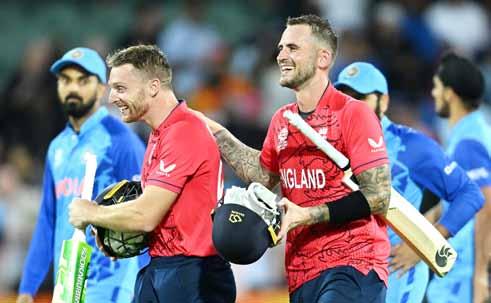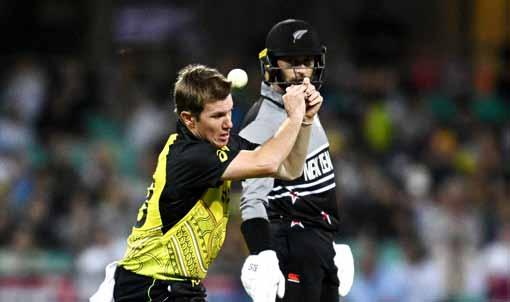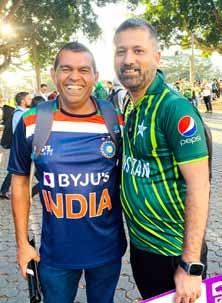
5 minute read
The best since the first
from 2022-11 Melbourne
by Indian Link
By RITAM MITRA
Call it recency bias if you must, but the 2022 T20 World Cup was the best edition yet of the tournament, at least since the first. With a mandatory quota of those spinetingling “where were you when…” moments, punctuated by a plethora of upsets and a dramatic final in which England prevailed, first-time hosts Australia delivered a spectacle that captured the attention and imagination like no other T20 tournament has managed in a long time.
There is something to be said for a close-fought tournament with the right dose of mystery and a regular cadence of twists and turns; where the semi-finalists were not known until the dying group stages, helped by results like Zimbabwe toppling Pakistan, Ireland defeating England and the Netherlands taking down a rampant South Africa. These were surprises, but rarely shocks: the T20 format is cricket’s biggest leveller, and there was a great deal of quality and talent in each team.
The PL ayeRs
The players, of course, lay at the centre of it all. T20 cricket is now the most professional form of the game – given the sheer sums of money involved – and it showed in the way even Associate nations matched it with the best in the disciplines of fielding and fitness, the hallmarks of professionalism in a cricket team.
The LOCaL COnDITIOns
Beyond the players, the most important role was played by the near-perfect Australian conditions.
This is not a nod, of course, to the relentless rain – particularly in Melbourne – for which the malingering La Niña system can be thanked. Even then, as Sydney residents will attest to, it is no small miracle that all games at the Sydney Cricket Ground were completed without interruption, such has been the volume of rain in what is already the city’s wettest year on record.
But it is the other elements which set the scene for an enthralling tournament. While flat pitches, small grounds and the absence of seam or swing are the scourge of those who covet a close contest, Australia delivered the very opposite, and it showed in the closeness of the contests.

The size of Australian grounds, for instance, ensured that teams stacked with power hitters could not simply blast their way to unsurpassable totals. This is because large boundaries mandate not just powerful, but smart cricket. A canny fielding captain and disciplined bowling are far more effective on bigger grounds, while the fittest, most resourceful batters – Virat Kohli, Kane Williamson – can also often extract more value here than they otherwise might.
The TImIng Of IT aLL
Staging the tournament in October – a necessity to preserve the Australian summer of cricket – also paid dividends, with pitches still carrying a heartbeat. It gave us a sight that has been absent from cricket down under in recent years: a swinging, seaming white ball. Swing and seam rebalanced the dynamics in australian conditions, a blockbuster format, and unpredictable, edge-of-your-seat competition, made Icc T20 World cup 2022 one of the best ever. the critical powerplay, when bowlers would typically be on a hiding to nothing; indeed, this was, statistically one of the hardest T20 World Cups in history to be an opening batter. Reflecting on the likes of Arshdeep Singh, Shaheen Shah Afridi, and the fearsome South African pace quartet, it is no surprise why.
KUDO s TO yOU, ICC
The ICC too, must be given credit where due: it has absolutely nailed the format of the T20 World Cup. The qualifying stage, typically a perfunctory curtain raiser between weaker nations, was riveting and, thankfully, subject to the same broadcast production standards as the Super 12 stage. It gave us an early exit by two-time champions West Indies, a staggering upset by Namibia over Sri Lanka, and a lastgasp qualification by the Netherlands – who would go on to defeat South Africa in perhaps the most consequential upset of all. The Super 12 format is also perfectly punishing; even a single loss can be devastating, and a big loss tournament- ending, as Australia suffered at the hands of New Zealand. This is how it should be: world titles should not be easily won, and each game must be given context. By winning their last match against South Africa, for instance, the Netherlands secured automatic entry to the 2024 T20 World Cup in the USA and West Indies, a much more powerful motivation than the opportunity to merely play spoilsport.



Even in the afterglow of a tournament as successful as this, the ICC has one key lesson to learn: Associate cricket must not be taken for granted, and ongoing investment is critical. Governing boards, too - particularly the “Big Three” of India, Australia and England - must open up to novel ideas, such as permitting Ireland and Scotland to participate in The Hundred, or playing warm-up matches for England tours against the Netherlands, instead of against county sides.
The ICC is onto a winning formula here; one can only hope that the ICC recognises why.
By RITAM MITRA
If India’s T20 World Cup campaign started with a bang against Pakistan, it ended with the smallest of whimpers against England, in a ten-wicket thrashing that consigned India to its latest in a long line of defeats in knock-out games. The post-mortem is no doubt already underway, but so often have these conversations been held of late that there will be a sense of déjà vu about it all.
India’s tournament started with the brightest of sparks, against a rampant Pakistan pace attack. But other than against the likes of the Netherlands and Zimbabwe, rarely did India look like a team who would genuinely frighten oppositions. Even against Bangladesh, India avoided disaster thanks largely to a chaotic period of brainless batting by Bangladesh. Instead, the brilliance of Virat Kohli and Suryakumar Yadav papered over significant cracks in the team – and uncharacteristically, many of these were in the batting department.
There are many reasons that can be ascribed to India’s abysmal record in knockout cricket, but the first and most important aspect is personnel.
India’s selection strategy at this tournament was dubiously defensive, at best. India preferred picking the lumbering Ravichandran Ashwin over leg-spinner and genuine wicket-taking option Yuzvendra Chahal (who didn’t play a game in the tournament), and the waning Dinesh Karthik over the explosive Rishabh Pant.
The side also persisted with KL Rahul, who was regularly unimpressive, despite the more dynamic Deepak Hooda warming the bench.
Omitted from the squad altogether were young players like Sanju Samson, Shreyas Iyer and Shubman Gill, who have proved that they can match it against the best, and are unbeleaguered by past failures.
Hindsight is of course, 20/20, but from the outset, Rahul Dravid and Rohit Sharma would have done well to learn from the aggressive approach to selection by MS Dhoni ahead of the 2007 T20 World Cup, which remains India’s only T20 World Cup title. Controversially at the time, Dhoni ditched experience in favour of boldness and youth – and the likes of Ashwin would never have made that squad, let alone the playing XI.
The benefits of youth are overstated at times, but they go beyond athleticism in the field; youthfulness in a team breeds an infectious sense of fearlessness, the key aspect of the game in which India has struggled heavily in the last decade or so.
It mustn’t be forgotten that India were missing two of its most important players through injury, in Ravindra Jadeja and Jasprit Bumrah. Both play critical roles for India, particularly in limited overs cricket.
But in the same way, so too was England missing Mark Wood and Dawid Malan, both first choice players, through injury







